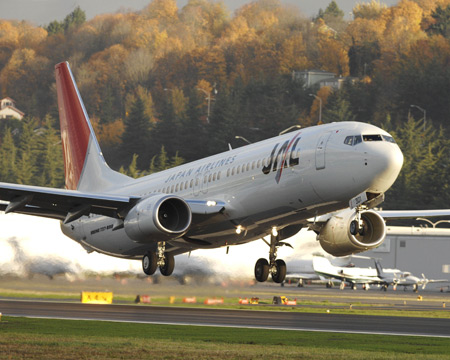Oneworld carrier returns from bankruptcy protection but faces challenges ahead as Japan begins earthquake recovery
Japan Airlines has emerged restructured from its bankruptcy protection only to face a new challenge as the country recovers from the deadly earthquake and tsunami in March, and the nuclear crisis that followed.
The oneworld carrier completed its reorganisation in March, after filing for bankruptcy protection in January 2010.
 |
|---|
The airline filed for bankruptcy protection under the weight of ¥2.3 trillion in debt. It was kept in operations by the Japanese government, with the government-backed Enterprise Turnaround Initiative Corporation pledging up to ¥900 billion to keep it operating while it restructured. Creditors also agreed to forgive ¥730 billion of the airline's debt.
JAL has since rolled out measures to cut losses and return to profit, including retiring 103 aircraft. This saw larger aircraft such as its Boeing 747-400s phased out - the last of which was retired in March - in favour of small and medium-sized jets including 737-800s and 787s. Its first Dreamliners should finally arrive this year after delays. Other measures included cutting 16,000 jobs, suspending 45 routes and closing 11 overseas bases.
JAL has also steadily sold off stakes in non-core businesses such as several ground handling and travel subsidiaries. Late last year, it streamlined its business units and appointed new executives to support its restructuring plan. In April, it also embarked on its joint venture with oneworld partner American Airlines on transpacific routes.
JAL plans to make a comeback on Japan's stock exchanges in the first half of 2013, its president and chief operating officer Masaru Onishi has said. JAL's shares were delisted in February 2010.
While JAL has been restructuring, All Nippon Airways has steadily embarked on its growth plans, including launching a new low-cost carrier which aims to begin operations in early 2012. Following the opening of Tokyo's Haneda Airport late last year to international scheduled flights, the Star Alliance airline has opened up new routes and aims to leverage on Haneda to grow its network.
However, the Japanese carriers now face a fresh challenge in light of the 11 March earthquake and tsunami. The disaster left thousands of passengers stranded at Tokyo's Narita and Haneda airports in its immediate aftermath as flights were grounded, but the airports say it is not clear yet what losses they will incur.
Several international carriers cut flights to Tokyo as travel demand plummeted. At Narita, officials expect minimal impact on its financial results for the year ending 31 March 2011, but say it is too early to estimate any losses resulting from the disaster in 2011-12 as the situation is still "fluid".
The operator of Haneda airport's two domestic terminals estimates passenger numbers have declined by up to 40% since the disaster, but the airport is not yet able to determine the size of any financial losses resulting from the crisis.
Responding to weaker travel demand in the aftermath of the disaster, JAL has cut capacity on certain domestic and international routes. It has downsized aircraft used on some routes, such as operating 737-800s between Tokyo Narita and Guam instead of 767-300ERs.
Source: Airline Business























